 Mentoring Project:
Mentoring Project:
Gera Woltjer and Gosia Wlodarczak
ABOUT
Gera: This is a one-year tailored mentorship between myself, the mentee, and Gosia Wlodarczak as mentor, taking place throughout 2016. We have agreed on one Skype session each month and on visits during Gosia’s residency projects this year.
My responsibilities are to make the mentorship as effective as possible and work on new bodies of cohesive work, apply for exhibitions, residencies and public art, planning and so on. This is what I really want to do and I dedicate most of my time to this. I have to keep a record of every meeting and document the mentoring process.
Gosia has to prepare for the meetings, switch from her busy practice and work commitments to my practice, engage, share insightss, experience and expertise with me. It is an investment, it needs trust and it takes time away from her creative practice.
In May I went to Canberra when Gosia was artist-in-residency at Segue, a festival and platform for an Australia-Europe cultural dialogue, exploring the cultural interplay between the continents of Australia and Europe. There, Gosia did an eight-day drawing performance “Segue 16: stCloud, Frost Drawing” in several location for the National Gallery of Australia, Canberra Museum and Gallery, Department of Foreign Affairs and Trade and The Street Theatre.
It was an intensive time, observing Gosia’s performance, the dialogue, meeting people in the arts-industry, visiting all the art venues and exhibition, curators talks, art events, documenting and writing a logbook plus reporting. And most importantly, reflecting on its impact for my art practice.
We also have mentoring meetings in Fremantle during Gosia’s three-week endurance performance “A Room With A View” in the Fremantle Arts Centre, and her exhibition until 12 November.
> How will the mentoring project be funded?
The project is funded by the Department of the Culture and the Arts. And I am investing a smaller amountmyself into this project as well. I am really thankful that the DCA funding for this project has made it all possible. For me, it is life-changing.
> Why Gosia Wlodarczak as a mentor?
Gera: Gosia was my first thought. She is my favourite artist: I first came across her work HAPPINESS & TRUST in 2008 on the new Business and Law Department buildings, Edith Cowan University, Western Australia. Since than I have been following her art career. She is an experienced and successful artist with the same European background as me, and she is working and exhibiting internationally. That is my career aim too.
We both are living and adjusting in a 'new' country and this is an experience which has an impact on your own sense of self, your identity and on your art practice. This understanding of each other is an important base of this mentorship.
To make it an effective project: I want the best mentor possible. Gosia is an experienced mentor and does not see herself as a teacher.
> What are your goals?
Gera: I work with a plan of short and long term goals. Along the road I can tick off goals I have achieved and also add new ones. In this mentoring process I have gained a lot more clarity and I am able to adapt my own learning process to my needs.
Examples of my short time goals are to learn from my mentor’s challenges and achievements, to have critical discussion for my professional growth and develop my art practice to reach the next level. Probably one of the most important goals is to build my emotional confidence and find a healthy balance within my practice.
One of my long term goals is to have a solid and sustainable professional art practice.
And not to forget, to become a future mentor for other artists while contributing to the future of the arts.
> How are outcomes assessed?
Gera: The way I work with agendas for our mentoring sessions and reports after every session is a way of continuously assessing the process. I have to report everything back to DCA, the funder of this project. The outcomes of this project will begin to be reflected in my practice, in my art projects and in my work ,something it has already started to do.
 REFLECTIONS
REFLECTIONS
> Why is this the right time in your career for mentoring?
Gosia: I have already had two other mentoring projects and have to admit this one is the best. Why? Maybe because: Gera and I, we are both in the same age bracket (50s), we are both from Europe, and both emigrated late in life; Gera in her 40’s I in my 30’s.
We already lived through a similar length of working life, even though her art profession had a bit of a different angle (art teaching) and I have always been only a freelance professional artist.
Recently Gera decided to be a full time artist – and this fact alone – the ability to make this clear-cut decision – shows that this is a good time for her to be mentored – she doesn't want to waste time, she listens, she considers ones comments and input.
I think our age combined with length of experience is a good time in an artist's career as one has enough life experience to convert it to one’s work and enough courage to make decisions. It is easier to communicate and mentor when a person who is mentored understands the commentary; 'digesting' them through comparable life context.
Gera: In the Netherlands I was an art teacher and lecturer for 20 years as well as an artist. My art practice has always been in second place while I trained as an art teacher and forged a career in art education.
In 2008, I moved to Australia and in 2013 I made a career-switch and committed myself to a full-time artist career. As an untrained artist I worked hard on my professional development, but I kept running into my limits. I arrived at an impasse and to be able to jump to the next level, I needed the support of a mentor. I had previously lived in regional Australia and I now see myself as an emerging artist in the Perth art scene, even though I am a mid-career artist with 20 years of teaching and art-making.
During my residency at PICA (October to November 2014) I knew I needed a mentor, rather than going back to University. I did extensive research on making this mentorship work for me. Leigh Robb (former curator at PICA) became the bridge between me and Gosia when she helped me to get in contact with her.
> How do you benefit from critique?
Gosia: One always does. It is another angle to look at thinks, fresh gaze.
Gera: We have critical discussions about the subjects/matters related to the different art projects I am working on each time and about being an artist and the art practice in general. Gosia does not give me answers or solutions. During the sessions I make copious notes during our conversations, that I then analyse and incorporate into a report. The notes and report become working documents for me, which I immediately follow up and take actions on. It is a fast and effective learning process.
Gosia looks and thinks from different angles/perspectives than me, and she draws from much experience as an artist and from the arts industry. Our conversations and her perspective are inspiring and they work as a catalyst for me.
> Why do you need mentoring?
Gera: I have the bigger picture for my art career in mind. I wish to use my time as efficiently as possible and therefore I chose a mentoring project to achieve my goals as fast as possible alongside my studio work, applications, planning and every other aspect of being being an artist and sustaining an arts practice.
I am used to working in a structured way inside institutions such as high schools and university. As an artist I see myself often floating, passionate, inspired, overloaded with ideas and big art dreams, but not knowing how to narrow it down to the strongest work possible.
Gosia: Gera doesn't want to lose time - she is dedicated and determined - mentorship helps one analyse one’s practice but does it in more condensed way then studying – which is a prolonged process.
> Have the outcomes so far matched the goals?
Gera: So far they have. I have realised that I grew a lot during this mentoring project. The most important thing is that I gained a lot of confidence in my concepts and my abilities, which is what I badly need for my future plans and arts practice. I am very thankful Gosia agreed to my mentoring request, I value this a lot! This mentor relationship became a precious friendship.
Gosia: I think we are both happy about our results - I can see how Gera's stance is stronger and her conceptual decisions more clear. I gained a good friend.
> How has this mentoring project developed and benefited your arts practice?
Gera: I am learning and developing fast with my approach to making and I feel more grounded in my practice. I don’t get so stuck during the process stage in my studio practice and I more easily make decisions in my work. I am more focused on where to apply myself and I believe more in what I do.
Gosia: It is great good to have a professional friend with whom one can share and discuss art, ideas and can do it on a particular/matching level of understanding.
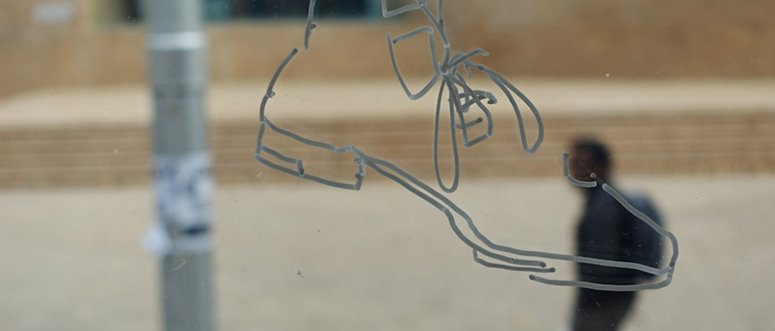
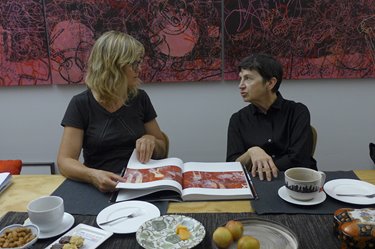
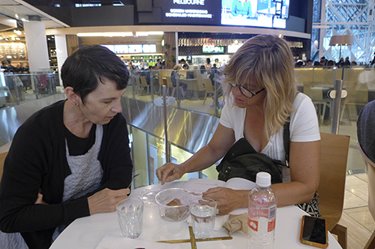
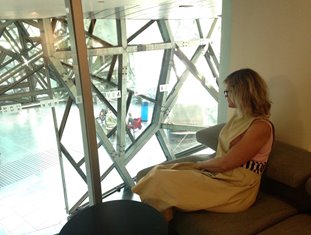

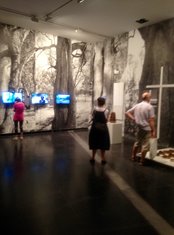
IMAGES: (top and middle) Gera Woltjer visiting Gosia Wlodarczak (Segue artist-in-residence) at the Street Theatre Canberra, 2016. Photographer: Longin Sarnecki. Images courtesy of the artist and the Street Theatre. (Bottom left to right) Detail of drawing performance by Gosia Wlodarczak at The Street Theatre for Segue 16: stCloud, Frost Drawing, 2016. Image courtesy of Gera Woltjer. Gera Woltjer and Gosia Woldarczak mentoring project: After a day of work meetings, 10 km walk and shops, a dinner and going through bibliography and art books. Photographer: Longin Sarnecki. Gera Woltjer and Gosia Woldarczak mentoring project: At the end of day 3 at the Emporium. Photographer: Longin Sarnecki. Gera Woltjer and Gosia Woldarczak mentoring project: NGV Australia, reflection and thoughts. Photographer: Longin Sarnecki. Gera Woltjer and Gosia Woldarczak mentoring project: Walking Melbourne. Image courtesy of the artist. Gera Woltjer and Gosia Woldarczak mentoring project: ACCA - Australian Centre for Contemporary Art. Exhibition visit Sovereignty. Image courtesy of the artist.